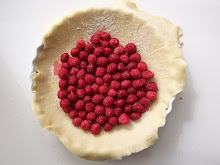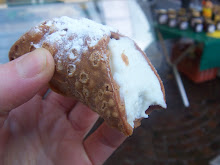
It started when friend of mine came over with a basket of pretty in pink sweet litchis. I have always been quite indifferent about them but their eye ball- like texture and sweet rosiness gave me inspiration. I decided to take the challenge, and go where no litchi has taken me before. I had to stock up and my first stop was at the farmers market, where, laid on the table was a stack of litchis still holding on to the branches as if their lives depended on it. They were big and plump and when I popped one in my mouth I experiences an explosion of taste. I took a batch with me but they were so good none were left. Once again I headed to the market and bought even more litchis. Once I was properly stocked it was time for work.
The result, as is often the case, took over my fridge, keeping a steady level of my daily litchi intake for a good few days.
This recipe did not make it into the article but instead I made these cakes of gooey goodness when I opened the refrigerator door only to find lots more litchis that needed using up.
Crumbly and moist, these sweet cakes are small yet lethal. Blind folded, you could be standing in the middle of a rose garden, eating a sticky toffee pudding.

Fairy cakes recipe adapted from here
Makes 12 small cakes or 6 large ones.
Ingredients
85g unsalted butter, softened
¾ cup golden caster sugar
1 medium egg
140g self-raising flour, sifted
¼ tsp baking powder
¼ tsp cinnamon
1 Tbs honey or maple syrup
100 ml milk, to mix (you might not need it all)
6 raw litchis, peeled with the stoned removed and chopped
Line a fairy cake or muffin tin with cases, and heat the oven to 180C.
Cream the butter and sugar together until light and fluffy.
While continuing to mix, drizzle the egg in gradually, adding a tablespoon of flour if the mixture looks like it's about to curdle.
Combine the flour and baking powder, and then gently fold into the mixture. Add just enough milk to bring the batter to a dropping consistency.
Gently fold the honey and chopped litchis.
Divide the mixture between the cases: if you prefer flat-topped cakes, then just cover the bottom of the cases, if not, you can half-fill them.
Bake for 20 minutes, and then turn out on to a rack to cool.
Top with Caramelized litchis, see recipe below.
Alternatively mix icing sugar with enough boiling water to make a thick paste, then smooth over the cooled cakes, and add decorations before it sets.
Eat quickly or freeze, tightly wrapped.

Caramelized litchi candy
Ingredients
1 cup unrefined cane sugar
1 cup water
15 fresh litchis, peeled, stone removed and halved
Preheat the oven to 200°C.
Place the sugar and water in a saucepan.
Add 4-5 litchis, stir and bring to a boil.
At this stage you can also add cinnamon and/ or chopped red chilli pepper, if you like.
Reduce the heat and cook over a gentle simmer for about 30 minutes, until the syrup has thickened.
Place the raw litchi halves in a roasting tray and pour the sugar syrup over them.
Bake for 1 hour, then reduce the oven temperature to 160°C.
Bake for a further 2-3 hours, brushing the sugar syrup over the litchis, and gently stirring them so that they all caramelize evenly, every 30 minutes or so.
Allow to cool.
The caramelized litchis and syrup can be used as an ice cream topping, served over cake or with an aged cheese.
They may also be added to a fairy cake batter.


























